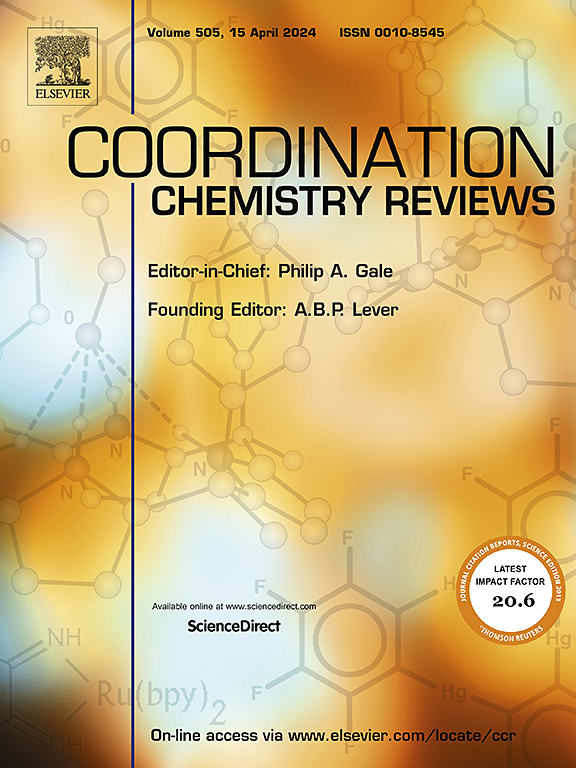Advancing catalyst design for H₂O₂ electrosynthesis via oxygen reduction reaction
IF 23.5
1区 化学
Q1 CHEMISTRY, INORGANIC & NUCLEAR
引用次数: 0
Abstract
The electrocatalytic reduction of O2 presents a sustainable pathway for producing hydrogen peroxide (H2O2), characterized by green solvents, zero‑carbon emissions, on-site production, and environmentally friendliness. Developing catalysts that are highly selective, active, stable, and derived from low-cost, earth-abundant materials is crucial for advancing this technology. In recent years, a diverse range of such catalysts, including metal-free carbon materials, covalent organic frameworks, metal-site decorated carbon materials, metal-organic framework-based materials, and earth-abundant metal compounds, have shown promise in selectively producing H2O2 via the oxygen reduction reaction (ORR). This review provides a comprehensive analysis of the underlying mechanisms in the electrochemical synthesis of H2O2 via ORR, highlighting the role of catalysts derived from abundant and inexpensive resources. Key factors such as microstructures, electrocatalytic performance, and strategies for tuning activities are systematically discussed, with a focus on regulating dopants, surficial functional groups, catalytic site configurations, phases, defects, and heterojunction hybridization. The challenges in material synthesis and optimization are thoroughly analyzed. Finally, the review highlights the remaining hurdles in H2O2 production via ORR and offers future directions for designing high-performance, low-cost electrocatalysts to enable sustainable and scalable H2O2 production.
推进氧还原电合成h2o2的催化剂设计
电催化还原O2为生产过氧化氢(H2O2)提供了一种可持续的途径,具有绿色溶剂、零碳排放、现场生产和环境友好的特点。开发高选择性、活性、稳定的催化剂,并从低成本、地球上丰富的材料中提取,对于推进这项技术至关重要。近年来,各种催化剂,包括无金属碳材料、共价有机框架、金属-位置修饰碳材料、金属-有机框架基材料和地球上丰富的金属化合物,都显示出通过氧还原反应(ORR)选择性产生H2O2的前景。本文全面分析了ORR电化学合成H2O2的基本机理,重点介绍了资源丰富且价格低廉的催化剂的作用。关键因素,如微观结构,电催化性能和策略的调整活动进行了系统的讨论,重点是调节掺杂剂,表面官能团,催化位点配置,相,缺陷和异质结杂化。深入分析了材料合成和优化方面的挑战。最后,综述强调了通过ORR生产H2O2的剩余障碍,并提出了未来设计高性能、低成本电催化剂的方向,以实现可持续和可扩展的H2O2生产。
本文章由计算机程序翻译,如有差异,请以英文原文为准。
求助全文
约1分钟内获得全文
求助全文
来源期刊

Coordination Chemistry Reviews
化学-无机化学与核化学
CiteScore
34.30
自引率
5.30%
发文量
457
审稿时长
54 days
期刊介绍:
Coordination Chemistry Reviews offers rapid publication of review articles on current and significant topics in coordination chemistry, encompassing organometallic, supramolecular, theoretical, and bioinorganic chemistry. It also covers catalysis, materials chemistry, and metal-organic frameworks from a coordination chemistry perspective. Reviews summarize recent developments or discuss specific techniques, welcoming contributions from both established and emerging researchers.
The journal releases special issues on timely subjects, including those featuring contributions from specific regions or conferences. Occasional full-length book articles are also featured. Additionally, special volumes cover annual reviews of main group chemistry, transition metal group chemistry, and organometallic chemistry. These comprehensive reviews are vital resources for those engaged in coordination chemistry, further establishing Coordination Chemistry Reviews as a hub for insightful surveys in inorganic and physical inorganic chemistry.
 求助内容:
求助内容: 应助结果提醒方式:
应助结果提醒方式:


